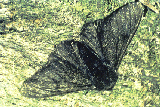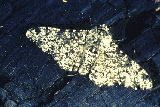|
The Peppered
Moth - An Update |
||
|
For years the story of the peppered moth, Biston betularia, has provided one of the best-known examples of natural selection in action. The story of the moth was outlined on pages 297-298 of the Elephant Book, and highlights the experiments of British ecologist H. B. D. Kettlewell. However, a recent book by Michael Majerus (Melanism -Evolution in Action) makes it clear that the peppered moth story has changed in recent years. |
|
|
| The light-colored form of the moth, known as typica, was the predominant form in England prior to the beginning of the industrial revolution. Shown at left, the typica moth's speckled wings are easy to spot against a dark background, but would be difficult to pick out against the light-colored bark of many trees common in England. |
|
|
|
Around the middle of the 19th century, however, a new form of the moth began to appear. The first report of a dark-colored peppered moth was made in 1848. By 1895, the frequency in Manchester had reached a reported level of 98% of the moths. |
||
| This dark-colored form is known as carbonaria, and (as shown at right), it is easiest to see against a light background. As you can well imagine, carbonaria would be almost invisible against a dark background, just as typica would be difficult to see against a light background. The increase in carbonaria moths was so dramatic that many naturalists made the immediate suggestion that it had to be the result of the effects of industrial activity on the local landscape. |  The "carbonaria" form. |
|
|
As noted on page 297 of the Elephant Book, coal burned during the early decades of the industrial revolution produced soot that blanketed the countryside of the industrial areas of England between London and Manchester. Several naturalists noted that the typica form was more common in the countryside, while the carbonaria moth prevailed in the sooty regions. Not surprisingly, many jumped to the conclusion that the darker moths had some sort of survival advantage in the newly-darkened landscape. In recent years, the burning of cleaner fuels and the advent of Clean Air laws has changed the countryside even in industrial areas, and the sootiness that prevailed during the 19th century is all but gone from urban England. Coincidentally, the prevalance of the carbonaria form has declined dramatically. In fact, some biologists suggest that the dark forms will be all but extinct within a few decades. For evolutionary biologists, the question behind the rise and fall of the carbonaria form is "Why?" Why should the dark phenotype have appeared so suddenly, come to dominate the population in industrial areas, and then have declined just as sharply when levels of pollution declined? To many biologists, the answer seemed obvious. In areas where pollution had darkened the landscape, the darker moths were better camouflaged and less like to be eaten by birds. Under less-polluted conditions, the light-colored moths prevailed for similar reasons. But was the obvious answer correct? That's what Kettlewell set out to check in a series of classic studies carried out in the 1950s. As described in Chapter 14 of the text, his results seemed to confirm that background camouflage was the key: |
||
|
However, in 1998, Michael E. N. Majerus of the Department of Genetics at the University of Cambridge carefully re-examined Kettlewell's studies, as well as many others that have since appeared. What he reported, first of all, was that Kettlewell's experiments, indicating that moth survival depends upon color-related camouflage, were generally correct: " Differential bird predation of the typica and carbonaria forms, in habitats affected by industrial pollution to different degrees, is the primary influence on the evolution of melanism in the peppered moth." (P. 116, Melanism - Evolution in Action, M. E. N. Majerus, Oxford University Press, New York, 1998). |
|
|
However, Majerus also discovered that many of Kettlewell's experiments didn't really test the elements of the story as well as they should have. For example, in testing how likely light and dark moths were to be eaten, he placed moths on the sides of tree trunks, a place where they rarely perch in nature. He also records how well comoflaged the moths seemed to be by visual inspection. This might have seemed like a good idea at the time, but since his work it has become clear that birds see ultraviolet much better than we do, and therefore what seems well-camouflaged to the human eye may not be to a bird. In addition, neither Kettlewell nor those who checked his work were able to compensate for the degree to which migration of moths from surrounding areas might have affected the actual numbers of light and dark moths he counted in various regions of the countryside.
Neither is true. In fact, the basic elements of the peppered moth story are quite correct. The population of dark moths rose and fell in parallel to industrial pollution, and the percentage of dark moths in the population was clearly highest in regions of the countryside that were most polluted. As Majerus, the principal scientific critic of Kettlewell's work wrote, "My view of the rise and fall of the melanic form of the peppered moth is that differential bird predation in more or less polluted regions, together with migration, are primarily responsible, almost to the exclusion of other factors." (p. 155). |
||
| So, what's going
on here?
Well, the best way to put it is that what we are seeing is the scientific process at its best. Majerus and other ecologists have carefully examined the details of Kettlewell's work and found them to be lacking. As Majerus explains, to be absolutely certain of exactly how natural selection produced the rise and fall of the carbonaria form, we need better experiments to show that birds (in a natural environment) really do respond to camouflage in the ways we have presumed, that the primary reason the dark moths did better in polluted areas was because of camouflage (and not other factors like behavior), and that migration rates of moths from the surrounding countryside are not so great that they overwhelm the influence of selection in local regions by birds. Until these studies are done, the peppered moth story will be incomplete. Not wrong, but incomplete. What we do know is that the rise and fall of dark-colored moths, a phenomenon known as "industrial melanism," remains a striking and persuasive example of natural selection in action. What we have to be cautious about is attributing 100% of the work of natural selection in this case to the camouflage of the moths and their direct visibility to birds. |
|
|
| Background Reading: I recommend the web page of Bruce Grant, Professor at the College of William and Mary, and especially his paper, "Fine Tuning the Peppered Moth Paradigm." Prof. Grant has also written to rebut charges that the Peppered moth story is fraudlent: "Charges of Fraud Misleading." Also: Michael E. N. Majerus' book "Melanism - Evolution in Action" can be found on many library shelves. His latest book is "Moths."
|
||
Ken
Miller
Brown University
Written in August, 1999
